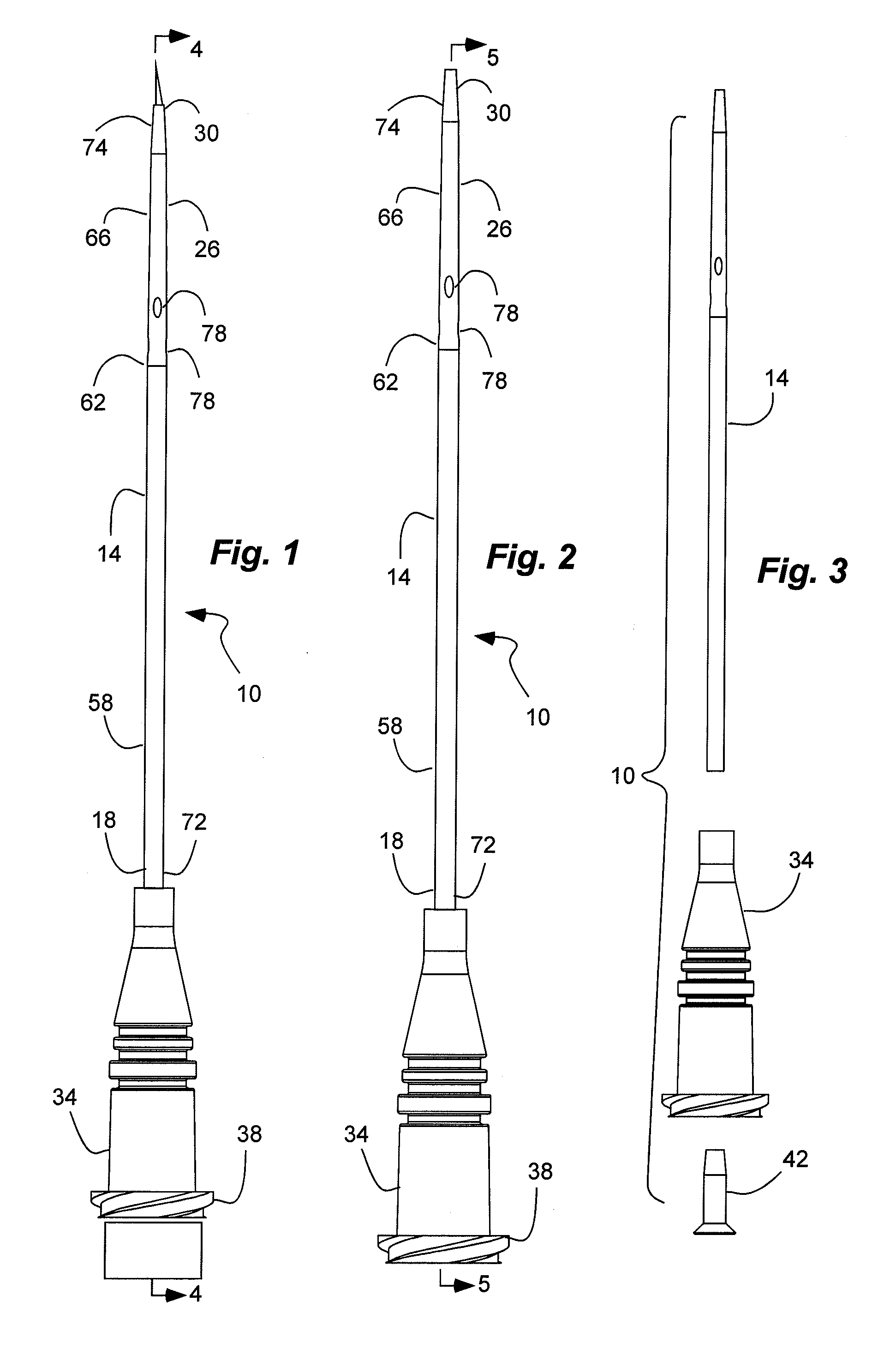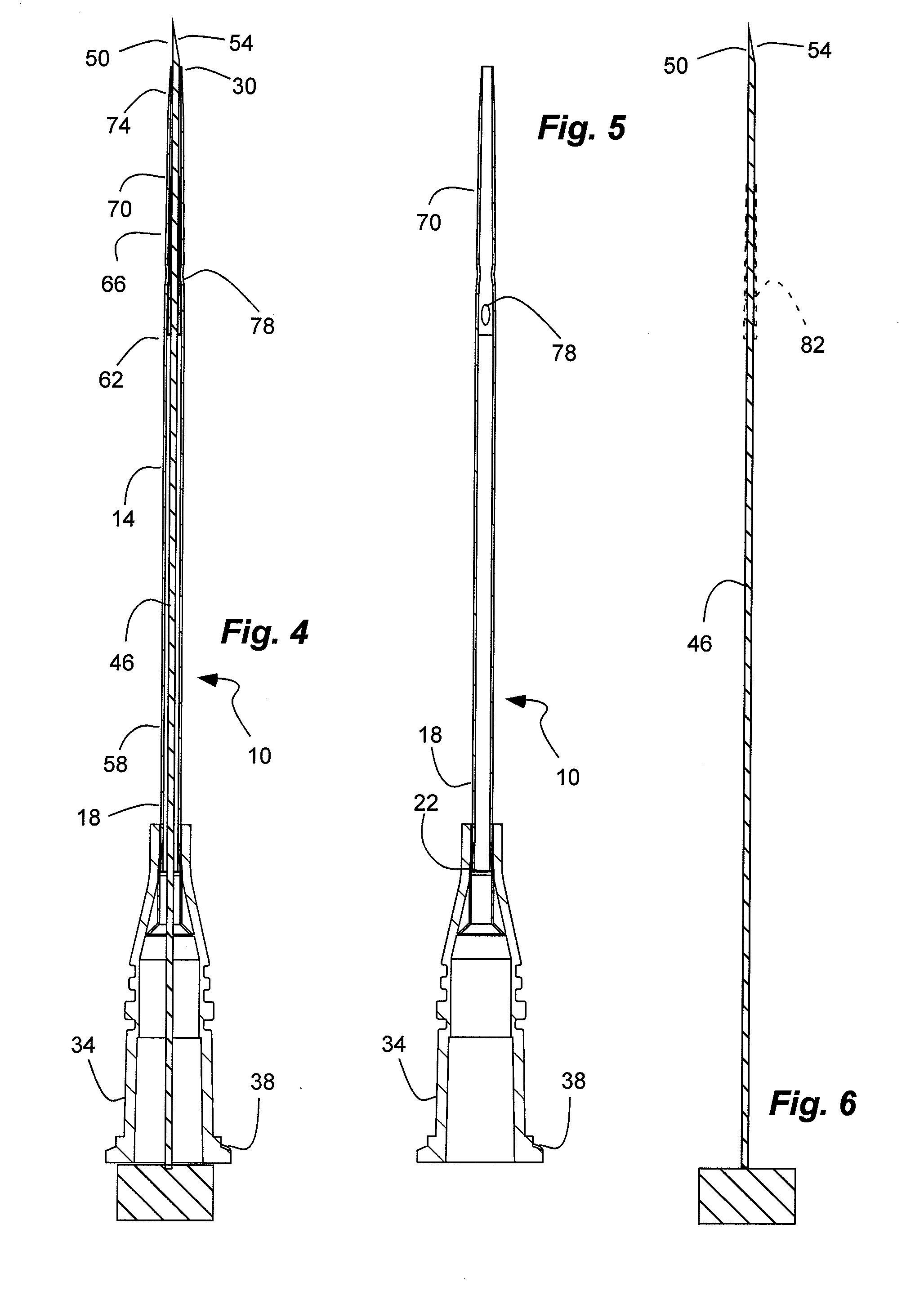High-flow tapered peripheral iv catheter with side outlets
a peripheral iv catheter and side outlet technology, applied in the field of peripheral intravenous (iv) catheters, can solve the problems of multiple iv insertion attempts, pain for patients, and iv tubing to split, and achieve the effect of high velocity
- Summary
- Abstract
- Description
- Claims
- Application Information
AI Technical Summary
Benefits of technology
Problems solved by technology
Method used
Image
Examples
example 1
[0051]An exemplary IV catheter in accordance with the above description was compared through computational fluid dynamics to other various catheter designs. The exemplary IV catheter had a 16 gauge (0.0403 inside diameter) inlet port, a 20 gauge (0.0253 inch inside diameter) outlet port, and four side outlet ports and a tapered configuration. The catheter was 2 inches long.
[0052]The exemplary IV catheter was compared to three other contrasting configurations for injecting or introducing a fluid. A first contrasting configuration is similar to the exemplary configuration, but without the side outlet ports. The second contrasting configuration was a straight 16 gauge (0.0403 inch inner diameter) catheter; while the third contrasting configuration was a straight 20 gauge (0.0253 inch inner diameter) catheter.
[0053]All four designs were subject to the same boundary conditions, i.e. outlet pressure, volumetric flow rate, laminar flow, fluid material, rigid wall, etc. All the catheters we...
example 2
[0058]An exemplary IV catheter in accordance with the above description was compared to a contrasting catheter that is commercially available and considered a standard design and size. The exemplary IV catheter had an 18 gauge catheter (with side outlet ports) and a 23 gauge stylet or needle. The contrasting catheter had an 18 gauge catheter and a 21 gauge needle. The flowrate of the two catheters was equivalent or improved, but the exemplary IV catheter had a piercing needle that is approximately 22% smaller in diameter and 39% smaller in cross-sectional area, than the standard sized contrasting catheter. The exemplary IV catheter required approximately 1.6 Newtons of force to achieve intraluminal position, while the contrasting catheter requires approximately 1.8 Newtons of force, thus resulting in a 0.2 Newton improvement in insertion forces to achieve intraluminal position.
example 3
[0059]An exemplary IV catheter in accordance with the above description was compared to a contrasting catheter that is commercially available and considered a standard design and size. The exemplary IV catheter had an 18 gauge catheter (with side outlet ports) and a 23 gauge needle. The contrasting catheter had a 22 gauge catheter and a 25 gauge needle. Both catheters had a peak insertion force of approximately 1.6 Newtons. Thus, with 1.6 Newtons force, the exemplary catheter is fully intravascular, the same as a much smaller 22 gauge catheter, but with a much higher flow rate of an 18 gauge catheter.
[0060]Referring to FIG. 9, another peripheral IV catheter 10b is shown that is similar in most respect to that described above, but with a Y-connection 90 and a double catheter configuration. The distal end 26 of the catheter 14 has the distal tapered conical shape 66 terminating at the outlet port 30 and defining the inner lumen conical taper with a conical internal shape. The Y-connec...
PUM
 Login to View More
Login to View More Abstract
Description
Claims
Application Information
 Login to View More
Login to View More - R&D
- Intellectual Property
- Life Sciences
- Materials
- Tech Scout
- Unparalleled Data Quality
- Higher Quality Content
- 60% Fewer Hallucinations
Browse by: Latest US Patents, China's latest patents, Technical Efficacy Thesaurus, Application Domain, Technology Topic, Popular Technical Reports.
© 2025 PatSnap. All rights reserved.Legal|Privacy policy|Modern Slavery Act Transparency Statement|Sitemap|About US| Contact US: help@patsnap.com



